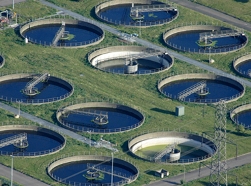CSG Holdings, Inc., a sand and gravel company in New Hampshire has been fined $150,000 for violating the Clean Water Act.
Researchers at Texas A&M University are investigating gray water, hoping that the reuse of 'soapy' water can become a statewide interest.
The Zero Waste Challenge's goal is to divert 100 percent of the 2013 tournament's waste away from landfills and into recycling and compost facilities –- not easy for an event that claims to attract the largest galleries of any golf tournament anywhere.
The contest attracted a record number of entries in 10 categories ranging from Air Quality and Climate to Wastewater.
The EPA and the Department of Justice announced that Roquette America, Inc. will pay a $4.1 million civil penalty for violations of the Clean Water Act and its National Pollutant Discharge Elimination System (NPDES) permit at its grain processing facility in Keokuk, Iowa.
GE’s wastewater treatment technology is now in use at the largest membrane bioreactor (MBR) facility in the state of Utah, providing reliable treatment of wastewater that exceeds current regulatory effluent discharge requirements.
A team of researchers led at the University of Maryland School of Public Health has found that the superbug MRSA is prevalent in several wastewater treatment plants across the U.S.
A ribbon cutting ceremony was held earlier this week to celebrate the completion of Austin’s Downtown Wastewater Tunnel project, which has improved wastewater collection for the central and downtown areas of the city.
According to a new study, silver nanoparticles in clothing can have a severe environmental impact on the environment. The nanosilver, which is toxic to bacteria and higher organisms, is released into water systems after clothing has been washed.
Schneider Electric has announced that it will implement a $7.9 million energy savings performance contract (ESPC) with the city of Denison, Texas.
The Georgia Environmental Protection Division (EPD) has reached a proposed agreement with a Stephens County wastewater treatment and composting facility. Under this agreement the facility will be required to address odor issues and correct problems associated with its operation.
The DEP and OEM announced that NYC’s official notification system will now issue rain-related advisories on 25 waterbodies in the area.
Growing Greener Plus Grants Offered by the Pennsylvania DEP
The organization's chair says the goal is make Ontario, CN "the place where the world buys its water management technology."

To reuse water requires capital that they would rather not spend if it's cheaper for them just to dispose of it. I think that's why we don't reuse that much. It might be more cost effective to figure out a way to reuse it than it would be not to.
Only a month after Hurricane Isaac swept past the city, the largest annual water quality conference will bring an estimated 18,000 attendees to the downtown Morial Convention Center.
Mike Matichich and colleagues looked at five thirsty industrial sectors, including oil & gas, chemicals, and semiconductors, to understand how water and wastewater costs are affecting business decisions.
Marking the 40th anniversary of the Clean Water Act, the EPA administrator is scheduled to speak Oct. 1 at the New Orleans conference.
Biological treatment plus ozone can reduce the amount of sludge coming from wastewater treatment plants by a factor of ten.
Permits call for major reductions in phosphorus; new limits on mercury, ammonia and temperature.